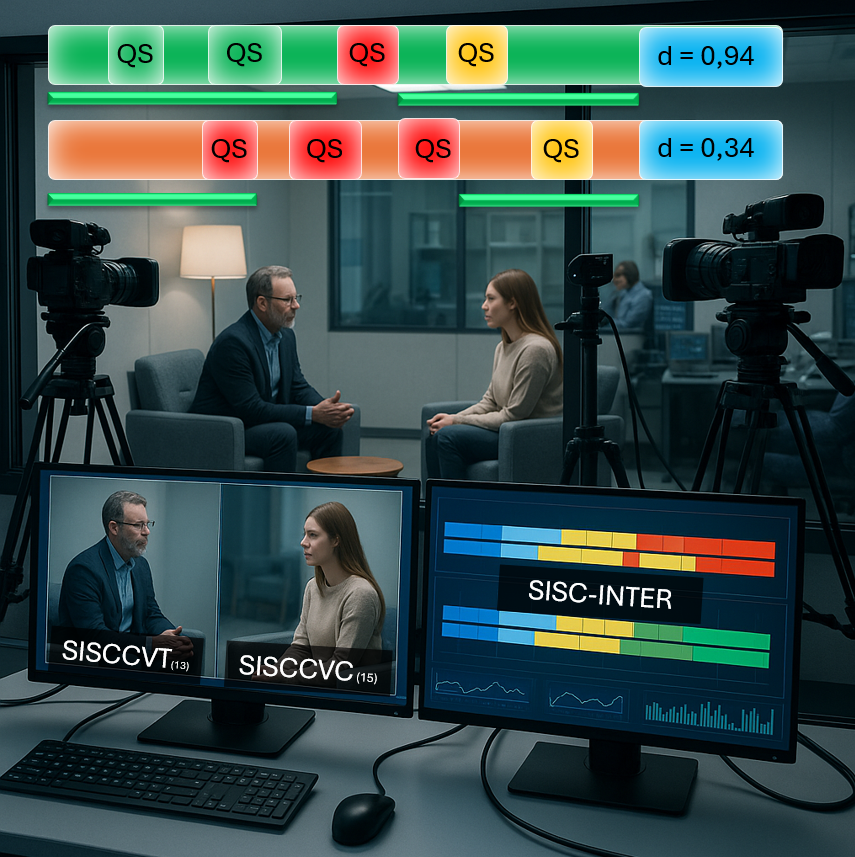What works in the Socratic Debate?
The Science of the Socratic Dialogue in Psychotherapy
What works in the Socratic Debate?

The Science of the Socratic Dialogue in Psychotherapy
The Spanish Revelation: How to discover what works in the Socratic Debate
Research Design, methodology and technology
First, let’s picture the series of studies:

The two bars on top represent a flow of the therapy, with fragments of Socratic Debates happening during the course of treatment. These can be classified as total success (green), partial success (yellow) and failed (red).
The case itself can be evaluated in terms of size effect, and be classified as globally succesful (green) or not (orange). It is possible to track both behavior change and verbal change, correlations between cognitive restructuring and behavior change and more.
The green line parallel to both bars represent the therapeutic alliance health for example. It is important that the Socratic Debates happens nested in psychologically safe environments. Also, it can represent the most meaningful outcome monitoring metrics.
The screen recording the elderly man (therapist) represents a system developed and validated, to accuratelly categorize functionally the behavior of the therapist. The other screen represents an analogous system to categorize the behavior of the client functionally. The third screen represents the INTER system to track the patterns between the two other systems. Jointly, these systems can track the interaction patterns that frequently lead to typical outcomes. What is targeted is the interaction patterns that are functionally selected for the therapeutic objectives. The Socratic Debate is one of many possible techniques to be studied within this design.
Multiple studies conducted by the Madrid research group involved various sample sizes – typically 7-19 cases per study with 9-11 therapists across different investigations. In total, more than 186 hours of dialogue were recorded and analyzed. All those cases were recorded both audio and video taped. The therapy sessions were analyzed interaction by interaction using the SISC-INTER-CVT system (Froján-Parga, Montaño-Fidalgo, & Calero-Elvira, 2006, 2010; Virués-Ortega, Montaño-Fidalgo, Froján-Parga, & Calero-Elvira, 2011).
They first developed the categories of behavior of each the therapists (Table 1) and clients (Table 2), then the relationships and frequencies of patterns of interactions (Table 3). The therapist behavior cattegories converged into 13 categories, the client’s to 15 cattegories. They validated the technology and methodology, which demonstrated high levels of inter- and intra-rater reliability, with Cohen’s Kappa coefficients consistently ranging from approximately .60 to .90 – considered “good” to “excellent”, to accurately classify the behaviors reaching up to 91% accuracy (Froján-Parga et al., 2008; Virués-Ortega et al., 2011; Ruiz-Sancho et al., 2013; Calero-Elvira et al., 2013). Then, once the behavior of each were functionally analyzed individually, a new software was linking the readings to understand the process of therapy: SISC-INTER-CVT (Froján-Parga et al., 2015; Alonso-Vega et al., 2022).
| Category | Definition |
|---|---|
| 1. Discriminative morphology (without direction) | Therapist verbalization leading to client behavior without indicating desired response direction |
| 2. Discriminative morphology (indicating direction) | Therapist verbalization leading to client behavior while indicating desired response direction |
| 3. Conversational discriminative morphology | Questions asked to check client’s understanding during conversation |
| 4. Low reinforcement morphology | Utterances showing mild approval (e.g., “Good,” “Right”) in neutral tone |
| 5. Medium reinforcement morphology | Utterances showing moderate approval (e.g., “Very good!”) with emphasis |
| 6. High reinforcement morphology | Utterances showing strong approval (e.g., “Excellent!” “Great!”) |
| 7. Conversational reinforcement morphology | Low-intensity reinforcement during client speech to maintain talking |
| 8. Punishment morphology | Utterances showing disapproval, rejection, or non-acceptance of client behavior |
| 9. Informative morphology | Utterances conveying technical or clinical knowledge |
| 10. Motivational morphology | Utterances explaining consequences of client behavior for clinical change |
| 11. Instructive morphology in session | Utterances aimed at stimulating client behavior within clinical context |
| 12. Instructive morphology outside session | Utterances aimed at stimulating client behavior outside clinical context |
| 13. Other | Any therapist utterance not included in previous categories |
| Category | Definition |
|---|---|
| 1. Providing information | Client verbalization providing therapist with descriptive information for evaluation/treatment |
| 2. Requesting information | Questions, comments, or requests for information from client to therapist |
| 3. Showing agreement | Client verbalization showing agreement, acceptance, or admiration for therapist’s utterances |
| 4. Showing disagreement | Client verbalization showing disagreement, disapproval, or rejection of therapist’s utterances |
| 5. Well-being | Client verbalization referring to satisfaction, happiness, or anticipation of well-being |
| 6. Discomfort | Client verbalization referring to suffering due to problematic behaviors or anticipation thereof |
| 7. Achievement | Client verbalization alluding to achieving therapeutic objectives or anticipation thereof |
| 8. Failure | Client verbalization alluding to failure in achieving therapeutic objectives or anticipation thereof |
| 9. Compliance with in-session instructions | Client verbalization implying total/partial compliance with immediate therapist instructions |
| 10. Anticipation of out-of-session instruction compliance | Client verbalization predicting task completion outside clinical context |
| 11. Description of out-of-session instruction compliance | Client verbalization describing completed tasks from previous sessions |
| 12. Non-compliance with in-session instructions | Client verbalization indicating non-compliance with immediate therapist instructions |
| 13. Anticipation of out-of-session instruction non-compliance | Client verbalization predicting non-completion of assigned tasks |
| 14. Description of out-of-session instruction non-compliance | Client verbalization describing non-completed tasks from previous sessions |
| 15. Emotional reaction verbalization | Client emission of emotional response with accompanying verbalization |
| Therapeutic Phase | Most Frequent Patterns | Description |
|---|---|---|
| Assessment | Discriminative → Providing Information → Low Reinforcement | Therapist questions → Client provides relevant information → Therapist acknowledges |
| Explanation | Informative → Conversational Discriminative → Showing Agreement → Low Reinforcement | Therapist explains → Checks understanding → Client agrees → Therapist confirms |
| Treatment | Instructional → Compliance/Non-compliance → Reinforcement/Punishment | Therapist gives instructions → Client complies/doesn’t comply → Therapist responds accordingly |
| Consolidation | Discriminative → Achievement/Well-being → High Reinforcement | Therapist inquires → Client reports progress → Therapist strongly reinforces |
| Cross-phase | Clinical Discriminative + Target Behavior + Positive Reinforcer | Most repeated three-term pattern across all phases |
| Effective Cases | Discriminative Stimulus → Target Behavior (R² = 0.446) | Strong predictive relationship in successful interventions |
| Ineffective Cases | Multiple scattered patterns with low predictability | Numerous sequential relationships without clear systematic patterns |
It is as if an expert behaviorist were watching CBT therapists treating their clients and eventually using the Socratic Questioning technique. When a Socratic Debate happened, the researchers analyzed the whole fragment from beginning to end of the subject matter. It was possible to connect different fragments of the same theme also. These Socratic fragments were evaluated as successful, intermediary and failed by the following definitions:
- Verbalizations Approximating the Therapeutic Objective (VAT): Client verbalizations showing agreement, acceptance, or well-being that are in line with or support the therapeutic objective being pursued in the debate. These include explicit agreement with therapeutic propositions and arguments or information that support the target therapeutic verbalization (Calero-Elvira et al., 2013; Froján-Parga et al., 2020).
- Verbalizations Intermediate with Respect to the Therapeutic Objective (VIT): Client verbalizations where the client does not clearly show agreement or disagreement with respect to the therapeutic proposition. This includes responses like “I don’t know,” “it depends,” or when the client provides information mixing arguments that support both agreement and disagreement with the therapeutic objective (Calero-Elvira et al., 2013).
- Verbalizations Opposing the Therapeutic Objective (VOT): Client verbalizations showing disagreement, discomfort, or complaints with what the therapist verbalizes, unless it constitutes therapeutic disagreement (which would be VAT). This includes arguments or information that go against the therapeutic objective of the debate, supporting the disagreement (Calero-Elvira et al., 2013).
They wanted to know if by applying the Socratic method the clients would approximate or distance from therapeutic objectives and a cognitive restructuration. Since they could accuratelly describe the interactions, it were possible monitoring verbalizations during the evolution of therapy.
Another advantage of recording everything: they could see the frequency in which interaction patterns converged in each possible outcome (VAT, VIT and VOT) across several cases and therapists, isolating the patterns themselves instead of the pattern of a therapist or the pattern effective only in specific cases, client or issues. In the most advanced phase of the research they applied both
Also, since the cases were known regarding their global outcome, it was possible to confirm that the cognitive restructuring produced effective behavior change afterwards, not only verbal change, either overt or expressed explicitly locally. The research design allow to study the technique and much more, the evolution of both verbal behavior and behavior patterns outside the clinical setting. It became possible to study global phases of therapy too: The cognitive phase of restructuring can be just one important milestone to overcome, and to study and provide a precise technique that could offer greater chances of success in this necessity is of great value to the CBT model, but one must know that it isolated doesn’t garantee overall success. Cognitive restructuring isn’t the whole of therapy.
With this design, it is possible to classify the success of the Socratic fragments and the success of the cases. It is possible thus to corelate changes in verbal behavior and in behavior outside of the clinical setting and check if shaping of the client’s verbalizations, the success of the Socratic technique, is in fact useful therapeutically or just a training in saying what the therapists shape the clients to say.
Results and implications for clinicians
What they identified that is mostly useful for clinicians I will state with as much brevity as possible:
- The Socratic dialogue in fact, even when framed as Guided Discovery, is a differential reinforcement pattern of the therapist that shapes the client’s verbalizations according to pre-established and agreed therapeutic objectives (Froján-Parga et al., 2013).
- The Socratic dialogue happens in three phases: discriminative, debate and consolidation. It moves from initial questioning through information sharing to final reinforcement and goal-setting (Froján-Parga et al., 2010). The phases show how patient responses evolve from opposing therapeutic objectives (24.78% initially) to increasingly supporting them (64.58% by the end phase), demonstrating measurable progress toward cognitive restructuring goals (Pardo-Cebrián et al., 2020).
- If the therapist precedes the Socratic questions with the preparatory strategy of explaining technically the reason of the process to reach therapy goals it is more likely that the client’s response is a verbalization that approximates to the therapy objective and less likely to produce intermediary and opposing verbalizations. This strategy was compared to the use of non-technical explanations, use of analogies, teaching reasoning skills, providing the target verbalization directly and questioning directly (Pardo-Cebrián et al., 2020). Table 4 summarizes and explains the findings.
- Expert therapists were much more precise and timely in using aversive components after VIT and VOT, and NOT after VAT (Montaño-Fidalgo et al., 2022). They also are more contingent-oriented than rule followers of the method as the novice therapists, suggesting a therapist must become more responsive AND consistent in his reading of the contingency AND skillful in doing the correct action in each situation. This suggests the metacognitive ability must be keen to monitor the therapeutic encounter.
- They discovered that in effective cases, discriminative stimuli (questions) successfully predicted target behaviors with R² = 0.446 (p = 0.01). In contrast, in ineffective cases, discriminative stimuli did not exhibit predictive capability with R² = 0.056 (p = 0.302) (Pereira et al., 2024). Few and better questions are the characteristic of effective cases. This gives an objective sucess criteria to orient deliberate practice of elaborating better Socratic questions. If a therapists train to improve the quality of his questions, he can track the initial standard frequency of success and see how his exercises are moving his baseline.
- The effective therapists and effective cases were predominantly marked by significantly lower use of punitive stimuli from the therapists compared to ineffective cases (25% vs 81% contingent relations between problem behaviors and punishers) (Pereira et al., 2024).
- The research emphasizes that fewer sequential relationships and higher systematicity characterize effective therapy, suggesting quality over quantity in therapeutic interactions – effective therapists use more targeted, systematic approaches rather than numerous scattered interventions (Pereira et al., 2024).
Table 4 demonstrates which therapist preparation techniques reliably produce therapeutic-aligned patient responses versus resistance or intermediate responses, providing statistical evidence for optimizing pre-questioning strategies.
Why it matters: These statistical patterns allow therapists to predict and control patient response quality by strategically choosing specific preparatory verbalizations, transforming questioning from hit-or-miss to scientifically-guided interventions.
Table 4: Preparatory Strategies vs Patient Response Types
| Preparatory Strategy | VAT (Therapeutic) | VIT (Intermediate) | VOT (Resistant) |
|---|---|---|---|
| Technical Explaining | R= 5.95** (Q= 0.81) | R= 1.51* (Q= -1.00) | R= -2.15 (Q= 0.35) |
| Non-Technical Explaining | R= 9.29** (Q= 0.68) | R= 2.07* (Q= 0.24) | R= 0.94 (Q= 0.14) |
| Using Analogies | R= 4.98** (Q= 0.85) | R= -0.98 (Q= -0.45) | R= 0.31 (Q= 12) |
| Motivating | R= 2.77** (Q= –) | R= -0.70 (Q= –) | R= -0.56 (Q= –) |
| Training in Reasoning Rules | R= 0.69 (Q= –) | R= 1.46 (Q= –) | R= -0.46 (Q= –) |
| Providing Target Verbalization | R= 2.58** (Q= 0.82) | R= 0.38 (Q= 0.21) | R= -0.73 (Q= -1) |
| Questioning (Unprepared) | R= 15.77** (Q= 0.62) | R= 3.21** (Q= 0.20) | R= 10.95** (Q= 0.57) |
Statistical Indices Explained
Patient Response Categories
- VAT (Verbalizations Approaching Therapeutic objectives): Patient responses that align with therapeutic goals – the desired outcome
- VIT (Verbalizations Intermediate with Therapeutic objectives): Patient responses that are neutral or partially aligned – mixed outcomes
- VOT (Verbalizations Opposing Therapeutic objectives): Patient responses that resist or oppose therapeutic goals – undesired outcomes
R Values: Adjusted Standardized Residuals
What they measure: Whether observed frequencies differ significantly from what would be expected by random chance.
Interpretation Scale:
- R > 1.96: Significantly MORE frequent than expected (positive association)
- R < -1.96: Significantly LESS frequent than expected (negative association)
- -1.96 < R < 1.96: No significant difference from chance
- Asterisks: *p < 0.05, **p < 0.01 (increasing statistical confidence)
Clinical Translation:
- High positive R: “This preparation strategy reliably produces this type of response”
- High negative R: “This preparation strategy reliably prevents this type of response”
- Low R: “This preparation strategy has unpredictable effects”
Q Values: Yule’s Q (Association Strength)
What they measure: The strength and direction of association between preparation strategy and response type.
Interpretation Scale:
- Q = +1.0: Perfect positive association (strategy always produces this response)
- Q = 0.0: No association (random relationship)
- Q = -1.0: Perfect negative association (strategy never produces this response)
- Q = —: Insufficient data to calculate (too few sequences observed)
Key Pattern Analysis
Most Effective Preparatory Strategies
1. Technical Explaining
- VAT: R= 5.95** (Q= 0.81) – Strongly promotes therapeutic responses
- VIT: R= 1.51* (Q= -1.00) – Significantly reduces intermediate responses
- VOT: R= -2.15 (Q= 0.35) – Reduces resistant responses
- Conclusion: Technical explanations create strong bias toward therapeutic-aligned responses
2. Using Analogies
- VAT: R= 4.98** (Q= 0.85) – Strongly promotes therapeutic responses
- VIT: R= -0.98 (Q= -0.45) – Reduces intermediate responses
- VOT: R= 0.31 (Q= 12) – Neutral effect on resistance
- Conclusion: Analogies reliably generate therapeutic responses while reducing ambiguity
3. Motivating
- VAT: R= 2.77** – Moderately promotes therapeutic responses
- VIT: R= -0.70 – Reduces intermediate responses
- VOT: R= -0.56 – Reduces resistant responses
- Conclusion: Motivational statements create positive therapeutic climate
Problematic Strategies
Non-Technical Explaining
- VAT: R= 9.29** (Q= 0.68) – Promotes therapeutic responses
- VIT: R= 2.07* (Q= 0.24) – BUT also promotes intermediate responses
- VOT: R= 0.94 (Q= 0.14) – Slightly promotes resistant responses
- Problem: Less discriminating – produces mixed response quality
Questioning Without Preparation
- VAT: R= 15.77** (Q= 0.62) – High therapeutic responses
- VIT: R= 3.21** (Q= 0.20) – BUT also high intermediate responses
- VOT: R= 10.95** (Q= 0.57) – AND high resistant responses
- Problem: Completely unpredictable – all response types equally likely
Clinical Applications
Precision Preparation Protocol
- For Maximum Therapeutic Response: Use technical explanations (Q= 0.81) or analogies (Q= 0.85) before questioning
- To Minimize Resistance: Avoid unprepared questioning (VOT R= 10.95**)
- For Response Predictability: Technical explanations show strongest discrimination (VIT Q= -1.00)
Strategic Decision Framework
- High-Stakes Situations: Use technical explanations for maximum control
- Complex Concepts: Use analogies for clarity and engagement
- Resistant Patients: Combine motivating + technical explanations
- Never: Use unprepared questioning with difficult topics
References
Calero-Elvira, A., Froján-Parga, M. X., Ruiz-Sancho, E. M., & Alpañés-Freitag, M. (2013). Descriptive study of the Socratic method: Evidence for verbal shaping. Behavior Therapy, 44, 625-638.
Froján-Parga, M. X., Calero-Elvira, A., & Montaño-Fidalgo, M. (2006). Study of the Socratic method during cognitive restructuring. Clinical Psychology and Psychotherapy, 18, 110-123.
Froján-Parga, M. X., Montaño-Fidalgo, M., & Calero-Elvira, A. (2010). Study of the Socratic method during cognitive restructuring. Clinical Psychology and Psychotherapy, 18, 110-123.
Froján-Parga, M. X., Montaño, M., Calero, A., García, A., García, Á., & Ruiz, E. M. (2008). Sistema de categorización de la conducta verbal del terapeuta. Behavioral Psychology, 16, 593-621.
Montaño-Fidalgo, M., Martínez-Sánchez, H., Froján-Parga, M. X., & Calero-Elvira, A. (2022). Verbal behaviour analysis of expert and inexperienced therapists applying the Socratic Method. Clinical Psychology & Psychotherapy, 29, 1-15.
Pardo-Cebrián, R., Calero-Elvira, A., & Froján-Parga, M. X. (2020). What works in the Socratic debate. Behavioural and Cognitive Psychotherapy, 49, 1-15.
Pereira, G.-L., et al. (2024). An idiographic microanalytical study comparing processes related to effective and ineffective outcomes. Journal of Contextual Behavioral Science, 33, 100801.
Ruiz-Sancho, E. M., Froján-Parga, M. X., Calero-Elvira, A., & Roldán-González, M. D. (2013). Análisis de la conducta verbal del cliente durante el proceso terapéutico. Anales de Psicología, 29, 779-790.
Virués-Ortega, J., Montaño-Fidalgo, M., Froján-Parga, M. X., & Calero-Elvira, A. (2011). Descriptive analysis of the therapist’s verbal behavior: Known-group validity analysis of the behavioral functions of clinical interaction. Behavior Therapy, 42, 547-559.

